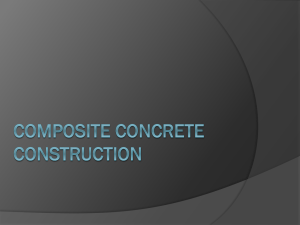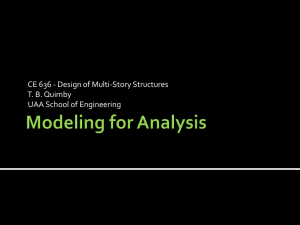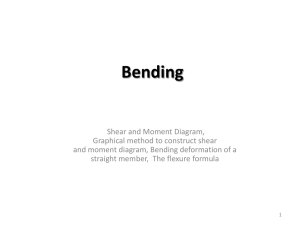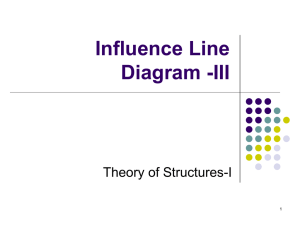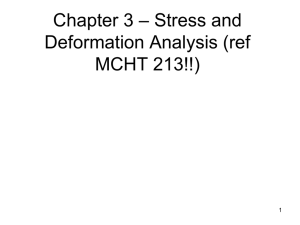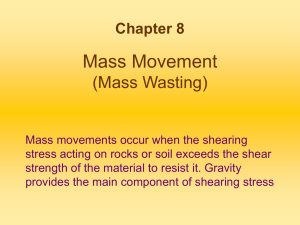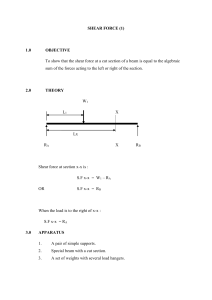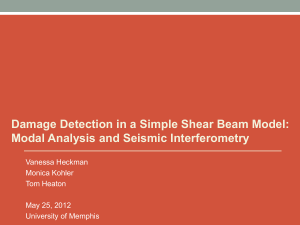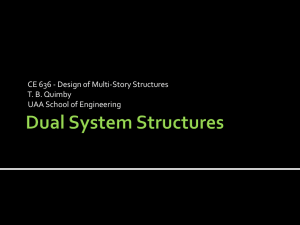Influence Lines or Bridges Under the Influence
advertisement
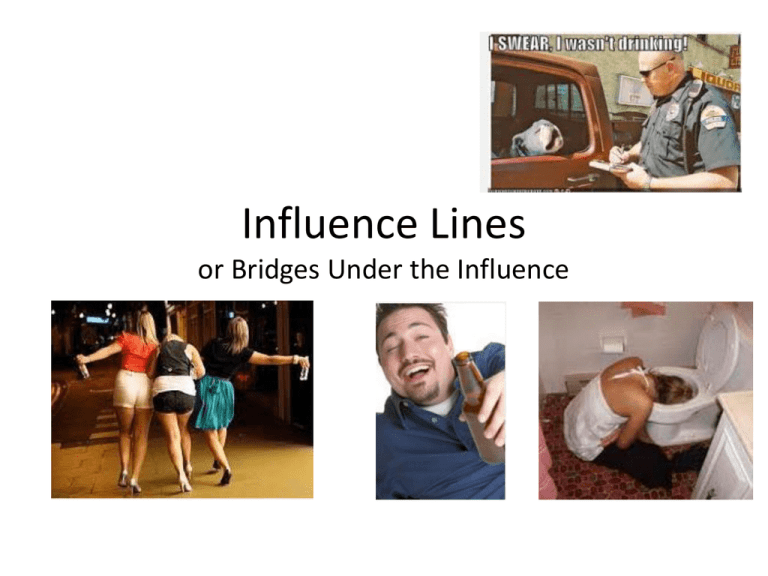
Influence Lines or Bridges Under the Influence What are They? At first glance they look like the shear and Moment diagrams we use for finding stress Maximums in beams. What is Different? Shear and Moment Diagrams show the Impact of “dead” or Fixed loads across an Entire beam or Structure. We use them to find out where peaks of shear or moment are located Influence Lines Influence lines show the impact of live moving loads At a single point as the load moves across the beam. They are important because sometimes we have moving traffic on bridges or beams that Contribute to stress and are not accounted for by loads at fixed positions. Methods of Producing Influence Lines You take a moving load of one unit weight. You pick your point of interest You place your moving load at Various points and use statics Principles to find the load at Your point of interest. Several Methods but the Tabulation Method is The easiest to understand Make life easier – for statically Determinate structures you get Straight lines (although the line Slope may change as the load Passes over key points. Why Do I Use a Unit Load of One for an Influence Line? 1 is easy to multiply by the weight of any thing Or any number of things I want. Influence lines are popular for studying the impact of moving – variable loads on bridges And other such structures. Sign Conventions A reaction acting upward is positive. On Shear Right Side Up Is Positive. More Sign Conventions Moments that bend upward are positive Lets Do a Simple Tabulated Influence Line Create an influence line for the Reaction at B as the unit load moves Across the beam. X Try different values Of x and compute The result. Our controlling statics equation is That the sum of moments about A must be 0. Observations The weight of our moving load is 1 (could be one anything) 2.5 M 1 10 M M1 = 1*2.5 = 2.5 Reaction B The points we picked to try for reaction At B were fairly arbitrary though they Follow a consistent pattern. Sum of Moments = 0 2.5 = 10 * X M2= 10* X = 10X X= 0.25 We Now Use Our Tabulation to Draw the Influence Line Note the straight line shape typical of statically determinate Beams. Lets Throw in Another Twist This time we will cantilever the beam Using a unit weight of 1 We calculate the reaction At B needed to keep the Sum of the moments at A Equal to zero And We Plot Our Influence Line Lets Try Some Shear and Moment Influence Lines We’ll try a total Cantilever beam. Lets try first for shear at point A Known Facts at Point A Therefore a load of 1 Anywhere on the beam Must produce a reaction Of 1 at A So What is the Shear Influence Line at Point A? Lets Try for Shear at Point B B How much of a shear load is transmitted through Point B when our load is between A and B? What About When the Load is Beyond B? Now Lets Do the Shear Thing When We Have Support at Both Ends I want an influence line for shear at point c What Happens When a Load is Parked Smack Dab on C? So How Did I Know the Shear was 0.5 in Each Direction? If the load is in the middle how much Support comes from each reaction? 7.5 M 7.5 M I can always refer to my reaction diagram For point B if I am unsure Next Consideration How much load is there Transmitted through point C when the load is totally at Point B? 0.5 Working on our shear line So What Happens In-between? 0.5 We know that for statically Determinate structures We should get straight lines ? 0 So Does Our Straight Line Hypothesis Make Sense? Remember our reaction at point B increases linearly until it has the full load? That means the shear that has to pass through C to reach support A is declining linearly - Yup it makes sense We now also know why we wanted to know the Reactions at A and B (they tell us how much Shear has to pass through our point of interest). The Moment has Come to Do Moments Lets think about the moment at A as our Moving load of 1 unit Cow moves down The cantilever. Tabulate and Plot X Moment 1 1 cowmeter 2 2 cowmeter 3 3 cowmeter The tabulation and equation 6 6 cowmeter 8 8 cowmeter 10 10 cowmeter 0 X 10 -10 So Lets Up the Toughness and Make it Point B What is the bending action at point B when our 1 unit Antelope Is between point A and point B. But What Happens When Our Antelope Goes Past B If we are 1 meter past B, what is the Moment at B? 1 unit Antelope * 1 meter = 1 antelope*meter (the cows and antelope illustrate that we do Influence lines with a unit weight of 1 – what ever That unit might be). The Result Now Lets Try it With Supports on both sides Here we take advantage of having computed the reactions at A And B as our unit load moves across the beam. The Computation Reaction at B We know We know the reaction at B because we have Already calculated it (or could have calculated it). Let us suppose that X = 2.5 meters and calculate it out. The moment at C has to cancel the Reaction at B X its lever arm of 7.5 M Referring to the Tabulation at B At 2.5 meters the reaction at B is 0.167 Plug that into our equation. We now solve for the moment at C We Build Our Table Off of the Principle We take our tabulated reactions at B and solve for Moment at C at each point as the load moves across And We Plot the Result There is One Mystery I calculated the increasing moment as The load approached C using the reaction At B. Then after the load passed I used The reaction at A. How did I know whether to use the reaction At A or the reaction at B for my moment Calculation at C? Actually It Didn’t Really Make In Difference to the Answer What if I calculated I would need The moment From reaction At A Reaction at A Using reaction at A But I would have to Directly also compute The opposing moment From my load The Answer Would Be the Same The amount of work needed to get The answer would not be the same. If you get the point. Assignment Plot the influence lines for the reactions at A and B Plot the influence line for shear at point C Plot the influence line for the moment at point C


